Pulsatile Blood Flow in Arterial Bifurcation Simulation, ANSYS Fluent Training
$80.00 Student Discount
- The problem numerically simulates the Pulsatile Blood Flow in Arterial Bifurcation using ANSYS Fluent software.
- We design the 3-D model with the Design Modeler software.
- We mesh the model with ANSYS Meshing software, and the element number equals 168367.
- We perform this simulation as unsteady (Transient).
- We use a UDF to define pulsatile velocity as a sinus function.
To Order Your Project or benefit from a CFD consultation, contact our experts via email ([email protected]), online support tab, or WhatsApp at +44 7443 197273.
There are some Free Products to check our service quality.
If you want the training video in another language instead of English, ask it via [email protected] after you buy the product.
Description
Description
This project simulates unsteady pulsatile blood flow in an artery bifurcation simplified model by ANSYS Fluent software.
The fluid domain geometry is designed in the Design Modeler, and the computational grid is generated using Ansys Meshing. The mesh type is unstructured, and the element number is 168367.
The inlet’s blood mass flow rate and outlet are equal to 0.001570178 and 0.00078576 kg/s, respectively. The blood pressure in the inlet is equal to 250 Pa, approximately 1.87515 mmHg. It is worth mentioning that blood pressure in large arteries in the human body varies between 120 and 80 mmHg.
Pulsatile Blood Flow Methodology
The pulsatile nature of blood flow is simulated using a User-Defined Function (UDF), which changes the inlet velocity according to flow time as a sinus function.
Pulsatile Blood Flow Conclusion
The simulation solver in this project is unsteady, and the results shown here are in the flow time equal to 0.162s, representing the peak value for the velocity function. One of the most exciting results of this project is the determination of prone regions of artery wall rupture.
As seen from the pressure contour at a flow time equal to 0.16s, the blood pressure on the bifurcation tip, where two flow streams diverge from each other, reaches high values equal to 125Pa, which is half the pressure of the fluid at the inlet.
Another interesting conclusion to make from the results is the regions that are most likely to form stenosis. In literature, areas with low Wall Shear Stress (WSS) are most likely to form stenosis. As shown in the figure illustrating the WSS values, the most likely region for stenosis formation is the tip of bifurcation.
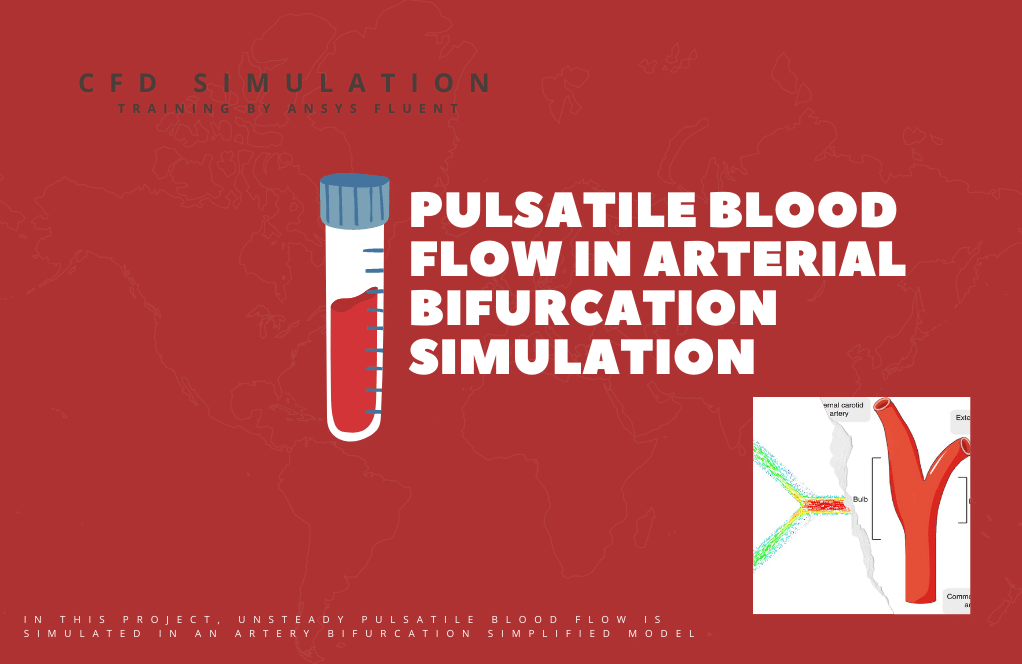
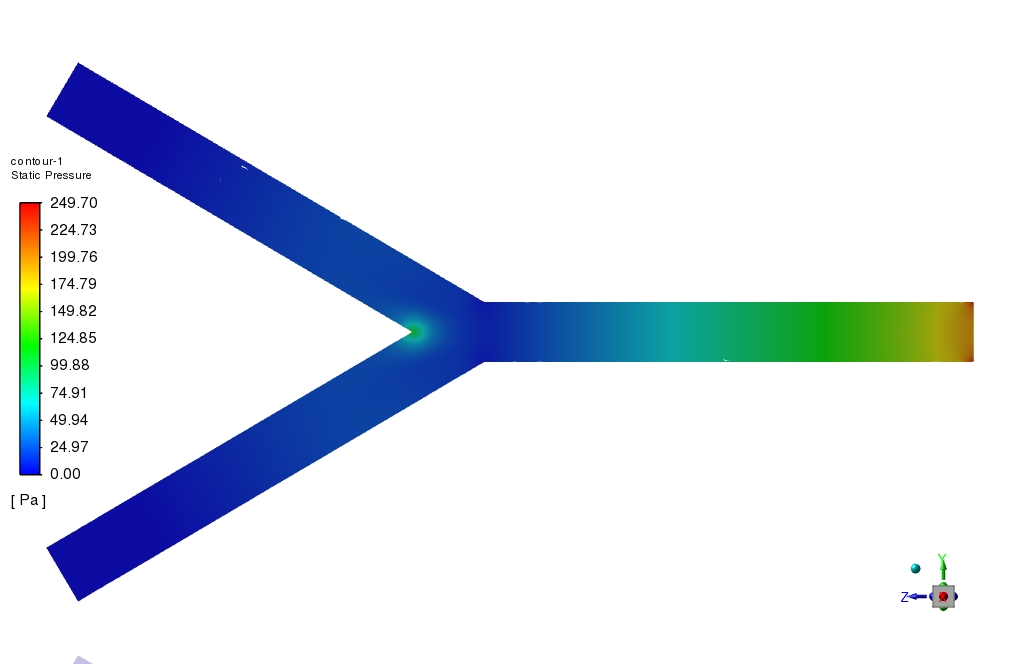
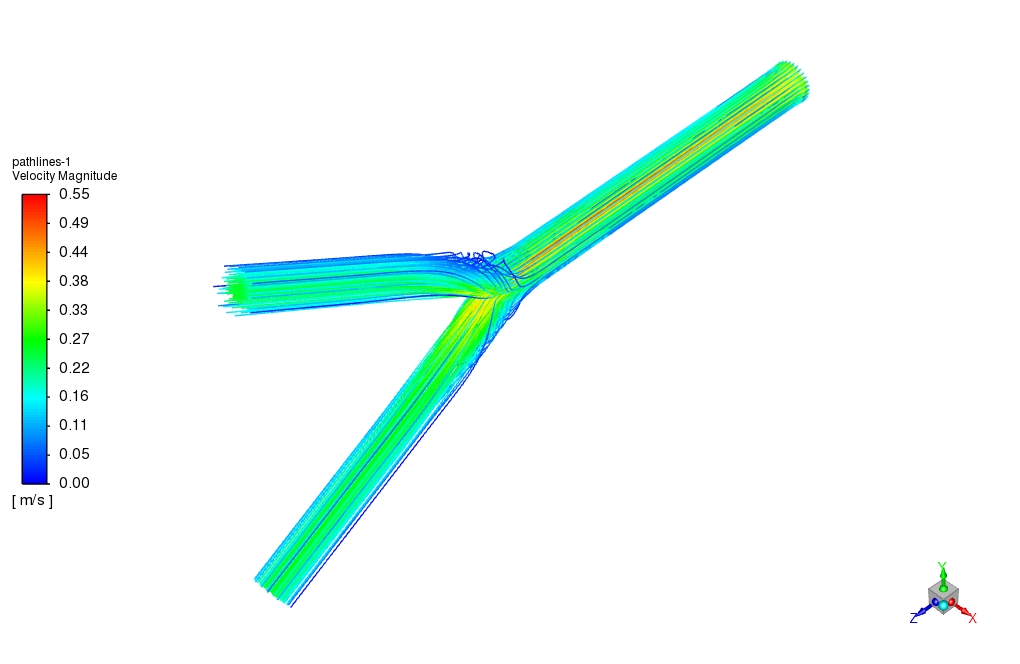
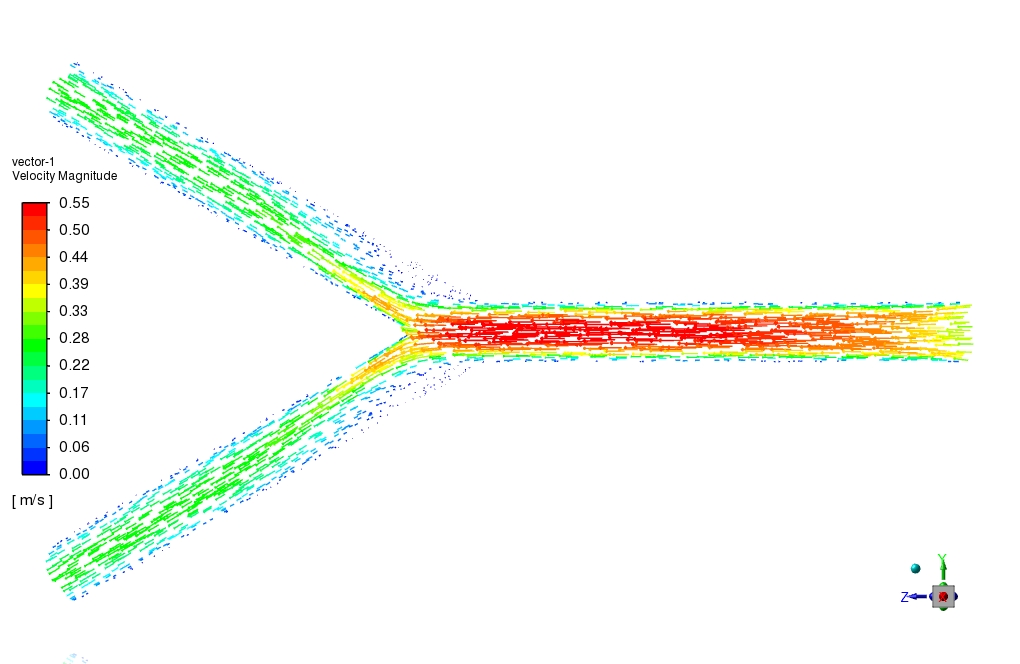
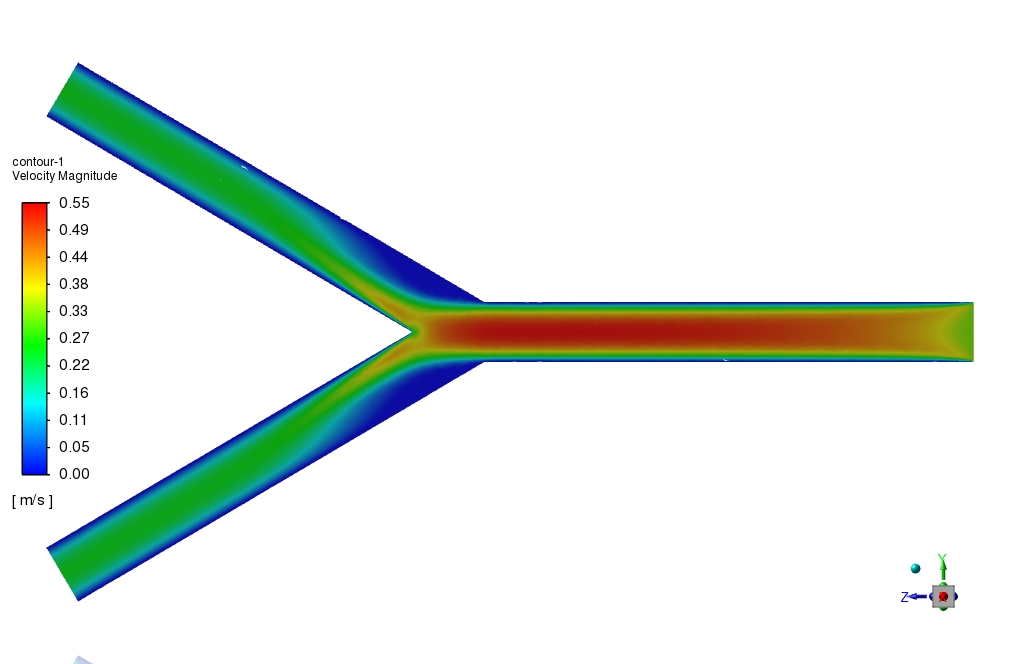
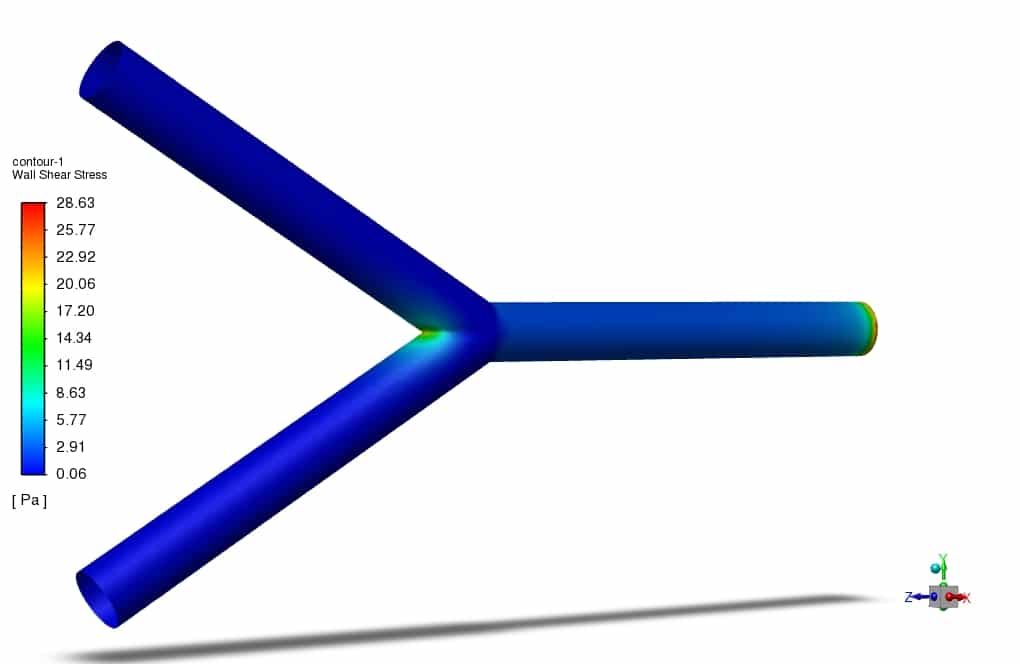
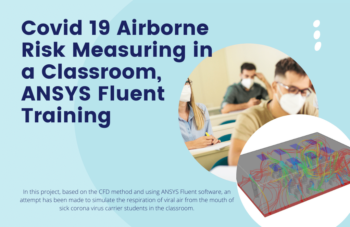
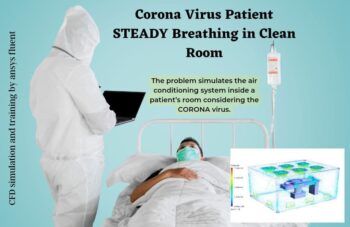
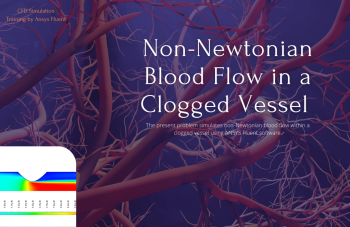

Rosamond Windler –
Can this model be used to simulate blood flow in other parts of the body?
MR CFD Support –
Yes, while the current model represents an arterial bifurcation, the same principles and techniques can be applied to simulate blood flow in other parts of the body. We are open to customizing the simulation based on your specific needs.
Mrs. Shaylee Dickinson PhD –
This is excellent work illustrating real-world physical processes with software simulation. Well done on capturing the pulsatile motion of flow with user-defined functions and highlighting critical areas in the arterial network. This knowledge could be invaluable in medical analysis and treatment design.
MR CFD Support –
Thank you for your positive feedback! We’re thrilled to hear that the accuracy and detail of our pulsatile blood flow simulation were valuable to you. Our goal at MR CFD is to provide simulations that can indeed add value to various fields, including the medical industry. It’s always great to know when we’ve made a difference. If there’s anything more we can assist you with or any other aspect of our services that intrigues you, please don’t hesitate to reach out.
Bridget Rodriguez –
The simulation clarity in determining the regions susceptible to artery wall rupture was exceptional! It really illustrated well how flow dynamics can pinpoint clinical concerns.
MR CFD Support –
Thank you for your kind words! We are delighted to hear that our simulation was able to faithfully represent complex blood flow dynamics and could aid in understanding crucial clinical implications. If you have further inquiries or require additional assistance, feel free to reach out.
Clint Hand –
The training was excellent! I was especially interested in the UDF implementation for pulsatile blood flow simulation. Thank you for a great learning experience.
MR CFD Support –
Thank you for your kind words! We’re delighted to hear that you found the training on pulsatile blood flow in arterial bifurcation simulation valuable, and the UDF implementation was brought out clearly. Your success and understanding of the simulation is our highest priority, and we appreciate your feedback. If you have any more questions or need further assistance, please don’t hesitate to ask!
Beryl Jacobs –
How does the simulation account for the bifurcation in the artery?
MR CFD Support –
The geometry of the model accurately represents an arterial bifurcation. The flow physics at the bifurcation are captured by solving the Navier-Stokes equations, which govern fluid motion.
Mrs. Abigayle Jerde V –
The use of UDF to simulate pulsatile flow is interesting. How specifically was the sinus function implemented, and how did you ensure its accuracy for modeling blood flow?
MR CFD Support –
In the simulation of pulsatile blood flow, the UDF (User-Defined Function) was written in the C programming language and used to define the sinusoidal variation of velocity at the inlet according to a time-based function. To ensure accuracy, the UDF would have parameters based on physiological data, such as the frequency and amplitude of blood pulsation, matching the cardiac cycle. This is validated by comparing simulation results with experimental data or established benchmarks in hemodynamics literature.
Evalyn Schimmel –
The project captures the complexities of pulsatile blood flow excellently. The attention to detail in simulating the variation of pressure at the bifurcation tip provides insight that could be beneficial for medical research. Great job on applying the UDF for simulating the sinusoidal nature of blood flow!
MR CFD Support –
Thank you for your review! It’s rewarding to hear that our simulation met your expectations and provided valuable insights. The application of the UDF to reflect physiological blood flow dynamics is pivotal in our efforts to simulate conditions as close to real-life scenarios as possible. We’re glad you appreciate the detail and dedication in our work. If you have any more feedback or need further information, feel free to reach out!
Macy Schulist MD –
How does the simulation handle the pulsatile nature of the blood flow?
MR CFD Support –
The simulation handles pulsatile flow by incorporating time-dependent boundary conditions. These conditions mimic the natural rhythmic contraction and relaxation of the heart, which is essential for accurately simulating blood flow in arteries.
Christine Kris MD –
I loved learning about how pulsatile blood flow simulation can help predict regions prone to artery wall rupture and stenosis formation. The use of UDF to simulate the sinusoidal nature of blood flow was particularly insightful. Great training material!
MR CFD Support –
Thank you for your positive feedback! We’re delighted to hear that you found the training material insightful and useful for understanding the complexities of pulsatile blood flow and its effects on arterial health. If you have any more questions or if you need further assistance with your future simulations, don’t hesitate to get in touch!
Citlalli Medhurst –
The simulations and results of the Pulsatile Blood Flow project are eye-opening, especially when it comes to understanding hemodynamics in arterial bifurcations. This provides great insights for biomedical research and device design. Well done on simulating this critical physiological process!
MR CFD Support –
Thank you for recognizing the importance and depth of the Pulsatile Blood Flow simulation. We are glad to hear that it provides valuable insights for your understanding of hemodynamics and its potential applications. Your encouragement motivates us to continue delivering high-quality simulations and training. We look forward to providing you with more innovative learning solutions!
Mr. Felipe Gerlach V –
The practicality and effectiveness of this course in simulating actual physiological conditions in humans really stands out—have others reported success in applying these simulation techniques to patient-specific cases?
MR CFD Support –
Thank you for your compliment! Yes, indeed, many researchers and engineers have successfully applied the simulation techniques covered in this course to patient-specific cases. The tools and methods taught enable detailed analyses of various physiological phenomena under specific patient conditions, assisting medical professionals in diagnosis and treatment planning.
Lonzo Kuhic Sr. –
I’m really pleased with the
MR CFD Support –
Thank you for the kind words! We’re thrilled to hear that you’ve found value in our Pulsatile Blood Flow in Arterial Bifurcation Simulation training. If you have any further feedback or questions, we’re here to help!
Domenic Connelly –
The figures are mentioned in the conclusion but I can’t seem to find them. Can you provide me with these visual results please?
MR CFD Support –
Certainly! The figures showing the pressure contour and Wall Shear Stress (WSS) values, which are critical to understanding the simulation results, are provided in the full training materials. If you’ve purchased the full training, you should have access to all graphical data visualizations that help illustrate these findings. If you don’t have them, please let us know, and we’ll make sure to get them to you right away.
Magdalena Leannon III –
Genuinely impressive work on modeling the pulsatile blood flow! The attention to physiological detail–like using UDFs to replicate a sinusoidal flow pattern–is remarkable. It strikes the perfect balance between complexity and usability, particularly with understanding areas prone to wall rupture. As a customer diving into biomechanical simulations, ANSYS Fluent’s capabilities shine through in this training. The insights offered on stenosis formation are invaluable. I feel better equipped to interpret such physiological phenomena and predict potential vascular issues using CFD—five stars for clarity and quality!
MR CFD Support –
We’re truly grateful for your kind words and happy to hear that you’re satisfied with our product. Our team puts a lot of effort into creating in-depth and practical training that serves the real demands of our customers. Understanding complex biological flows can be challenging, and we’re glad you felt our training made this task attainable and clear. Thanks for choosing our product and taking the time to write such a positive review. Your feedback motivates us to keep improving our services!
Ellsworth Little –
The simulation’s outcomes are impressive! The investigation of areas at risk of artery wall rupture and stenosis formation provides valuable insights. Could you please provide more details on how you determine the regions prone to these conditions?
MR CFD Support –
Certainly! The regions prone to artery wall rupture are identified by analyzing the pressure contours within the artery model. The segments that demonstrate significantly high pressure, such as the bifurcation tip in our simulation, are considered at higher risk. For stenosis formation, areas with low Wall Shear Stress (WSS) values are considered susceptible to stenosis. This is based on clinical knowledge that low WSS is associated with the deposition of atherosclerotic plaque. By examining the calculated WSS distribution in our results, we can spot those regions that have extraordinarily low WSS and label them as potential stenosis sites.
Mr. Easter Nicolas –
The training really detailed the effects of pulsatile flow and potential arterial health issues! It was enlightening to see how the simulation could predict problematic areas in arteries. Fantastic work by MR CFD.
MR CFD Support –
Thank you for your kind words! We’re thrilled to hear that you found the training enlightening and could gain insights into the complexities of pulsatile blood flow and its implications on arterial health. We work hard to create realistic simulations that can be truly informative for our learners. If you have any questions or need further information, feel free to reach out.
Curtis Kerluke II –
Fantastic learning experience! The tutorial on pulsatile blood flow simulation was exceptionally insightful. The use of UDF to replicate the natural rhythm of blood flow and also identifying regions at risk for stenosis made this complex subject comprehensible. Thanks MR CFD for an informative session.
MR CFD Support –
Thank you so much for your kind words! We’re delighted to hear that you had a fantastic learning experience and found the pulsatile blood flow simulation insightful. It’s our goal to provide comprehensive and useful materials that help our customers grasp complex subjects. If you have any more questions or need further assistance, please do not hesitate to reach out!
Reynold Tromp –
The training is fascinating, especially how you depicted the simulation of arterial bifurcation with pulsatile blood flow. It’s remarkable how MR CFD Company leveraged such sophisticated techniques to gain insights into physiological phenomena!
MR CFD Support –
Thank you for your positive feedback! We’re thrilled to hear you found the simulation of pulsatile blood flow in arterial bifurcation insightful. At MR CFD Company, we strive to apply advanced CFD techniques to model complex biological systems effectively. We’re glad the potential health-related applications impressed you!
Alejandra O’Hara –
The methodology indicates the use of a UDF for pulsatile flow. Could the same results be achieved using built-in Fluent functions, or is a UDF essential for accurate simulation in this case?
MR CFD Support –
A UDF is vital in this specific simulation to accurately mimic the physiological pulsatile nature of blood flow. While there are built-in functions in ANSYS Fluent for imposing flow variations, they may not provide the same level of precision or customization in representing the complex time-dependent waveforms evident in actual blood circulation.
Ms. Jazmyn Ondricka –
I purchased the ‘Pulsatile Blood Flow in Arterial Bifurcation Simulation’ course, and I am impressed with how complexity is simplified here. I’ve always found CFD simulations to be quite daunting, but the step-by-step approach makes it easier to understand. Plus, being able to predict regions at risk of stenosis will be incredibly beneficial to my research. Thank you for this in-depth yet comprehensible ANSYS Fluent training!
MR CFD Support –
Thank you so much for your review! We are thrilled to hear you found the training helpful and that it is contributing positively to your research. Understanding complex systems like blood flow is exactly what we aim to simplify for our customers. If you need any further assistance as you continue your learning journey, please don’t hesitate to reach out to us.
Lisa Zboncak –
I learned a lot from this pulsatile blood flow simulation project. Seeing practical applications of how blood pressure and flow rates can affect the arterial walls was enlightening. The use of UDF for simulating pulsatile flow as a sinus function was particularly impressive.
MR CFD Support –
Thank you for your positive review! We’re thrilled to hear that the project has been enlightening for you and that you were impressed by the use of the User-Defined Function to simulate the pulsatile blood flow. It’s our goal to provide useful and practical learning experiences. If you have any further questions or if there’s anything else you’d like to learn about, do let us know!